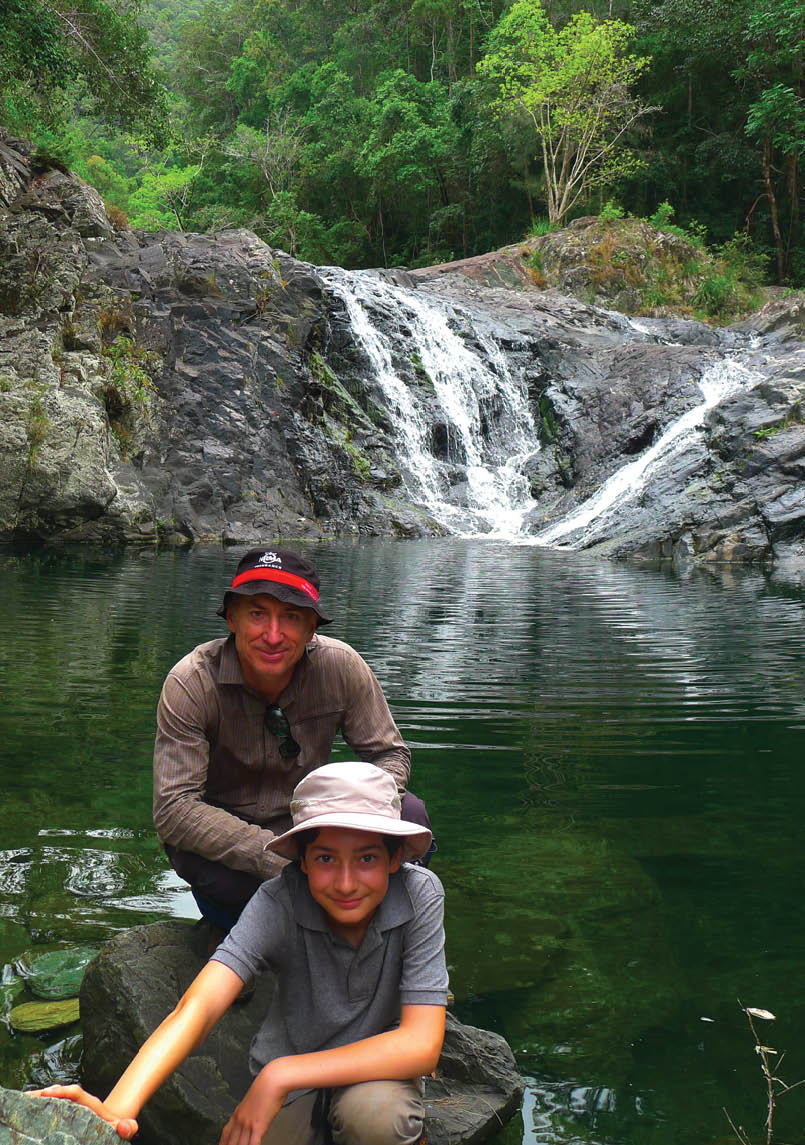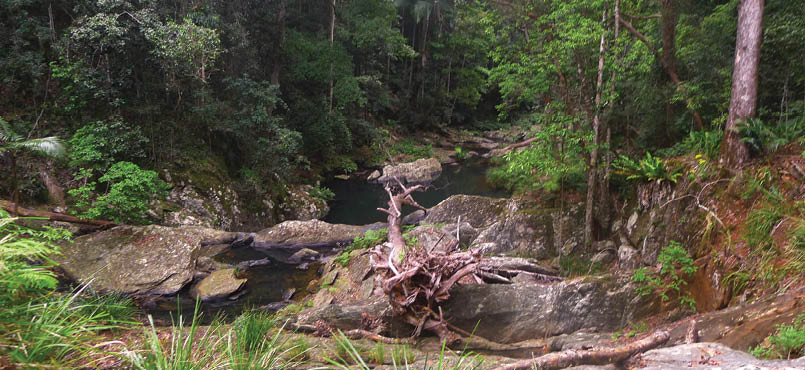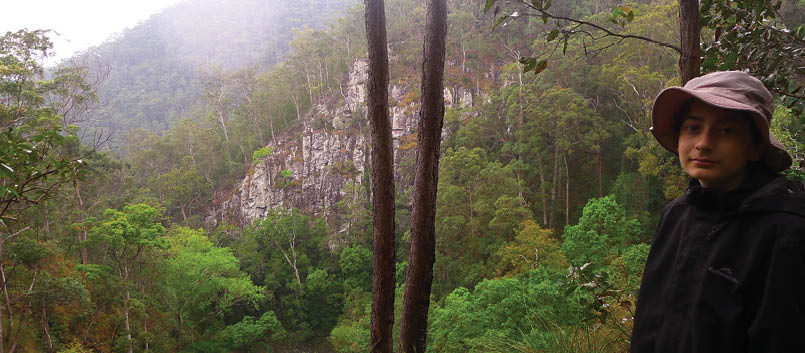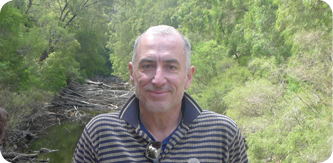


I froze as, just ahead of me, my 12-year-old son stepped within 10 centimetres of a very large, very colourful snake, shiny black with fluoro green criss-crosses. I later discovered it was a Coastal Carpet Python (non-venomous, though with a bite that packs a punch), but it was a sobering, time-ticking-slowly moment when it happened.
Craig with his son Royston at Artists Cascades

Conondale Range Great Walk
Craig N Pearce

14 | BWA December 2016
This was one of numerous snake encounters on the Conondale Range Great Walk, belying the topo map and info sheet’s claim that snakes are “rarely seen”. The first of a few red-bellied blacks we saw slithered off from within a metre of my son’s footfall immediately after arriving at Booloumba Creek camping area, while a much differently coloured variation of another Coastal Carpet Python meant we did our own snake-like sidle diversion past him deep into the walk.
The Queensland Government’s marketing people would probably prefer to adopt the delightful and ubiquitous Rufous Fantail as the walk’s icon, but if they used the red-bellied black snake the truth would not be misrepresented!
This proliferation of snake and bird life (Booloumba Creek was thick with kookaburras, for instance, and other more colourful feathered friends), along with lace monitors, frill-necked lizards and mountain brushtail possums, was a – mostly – welcome element of the deeply immersive, and intoxicating, bush experience the Conondale Range Great Walk provides.
And let’s face it, in Australia, if you’re not up for some snake encounters on your bushwalking, which ultimately adds to the “wow” factor, then you’ve probably chosen the wrong leisure pursuit. Even on short bushwalks I make sure my son and I wear long trousers and, more often than not, gaiters. When I see people going on a walk like this in trainers and shorts I’m thinking rather you than me …
This Great Walk is one of several of this ilk the Queensland Government has developed. It is in the Conondale National Park, about two hours north of Brisbane. After a three year “build”, the walk opened in 2010, and it has been constructed with an intelligent and sensitive “light touch”. Yes, there are some sections where steps, supported by rocks, have been cut into the incline and, yes, there are a number of designated walkers’ camps featuring water tanks (if you can get the damn taps to work …), toilets and wooden platforms, but for the most part what you get is a raw and rugged, up close and personal nature experience.
The immersive dimension of the walk is apparent as soon as you arrive at the starting point of Booloumba Creek. This is four-wheel drive access only, but you can park two kilometres away before the first of a series of creek crossings and walk into base camp.
With an atrium of palms and eucalypts towering over you and the rainforest giving the impression of wanting to subsume you within its depths, this is the beginning of a journey akin to walking underwater – with the addition of a lung- and mind-clearing amalgam of fecund vegetation and soil aromas. Combine this with the camping area’s swimming holes, peacefulness and a morning precipitation of leaves, silver daggers spiralling out of the sky, and I was in the park’s thrall before the walk had even begun.

Creek in in ConondaleRoyston Pearce
“... I was in the park’s thrall before the walk had even begun.
BWA December 2016 | 15

Helping accentuate the underwater feeling is that for 90% of the walk you’re in shade, which of course helps cool you down, a great advantage when lugging packs up some of the very challenging inclines. While parts of the walk pass through open, dry forested sections (including on management trails), much of the walk is navigated through confined spaces, where the rainforest and wet sclerophyll forests gradually claim you as a part of their own organic bodies.
Going by the small number of walkers on the trail in the ideal October school holiday period when our visit took place, and the unused look and feel of campsites and the track, it seems that the walk hasn’t really been “discovered” to the extent it deserves to be. But the minimal traffic it receives has probably allowed Queensland Parks and Wildlife Service to keep it light touch, enabling those who are privileged and fit enough to experience it to get very close indeed to the park’s unique characteristics.
Over 56 kilometres the walk passes through and by heavily forested ridges and gorges. The walk is designed to be undertaken over four days, punctuated by the walkers’ camps. If travelling in the prescribed clockwise manner, the first two days are physically challenging – if you’re silly enough to carry packs the size of ours, anyway – with plenty of steep inclines.
There are many small creek beds cutting through the hills’ adjoining creases, as well as countless waterfalls and creeks in the gullies. In the rain-heavy summer months the
walk must take on a different – or enhanced? – personality as many of the creek beds that were dry at the time of our walk would likely turn into torrents requiring caution.
The first day of the walk you encounter the beautiful Artists Cascades (hello red-bellied black #2 – lesson: red-bellied and creeks go together like damper and golden syrup) and the spectacular Booloumba Falls. The latter features a series of large, mini-falls with linked pools, leading to an impressive 40 metre-ish waterfall, while the Cascades is a fine point to gather your thoughts, as immediately following it is the walk’s most brutal climb. The final walkers' camp is adjacent to Summer Falls, another dramatic set of cascades and falls. This is faced across its gorge by a dramatic sheer cliff face comprised, the QPWS tells me, of old meta-sediments forming metamorphic and interbedded volcanic rocks.
Gondwana lives large. Think Jurassic Park – moss, lichen, fungi. On numerous occasions, islands of palm groves materialise, jolting with the way they changed the rainforest ambience. Staghorn ferns, another of my favourite walk features, also had some dense clusters, and a rock face full of ferns was an element to have any garden designer aching with envy. Dinosaurs would feel right at home.
Towering bunya pines and the striking flying buttress features of strangler figs were predominant, while another of those park icons could equally be the large, ropey vines
Gorge at Summer FallsCraig N Pearce
“Dinosaurs would feel right at home.
16 | BWA December 2016

that were everywhere, ideal for Tarzan, and clearly taking pleasure in trying to trip us up. Between them and the tree-avalanches which caused us (and obviously many previous walkers) to take track diversions, and the frequent refrain of branches and fronds smashing through the canopy, you are certainly kept on your toes.
While we weren’t standing at the time, we were also kept on our metaphorical toes by a 3am thunder, lightning and tropical downfall show on our final night. Protected only by our tent’s thin membrane, we were gifted yet another up close and personal nature experience that, perhaps more than any other, gave us an understanding of our relative insignificance and powerlessness in the face of nature’s temper/tempest.
During the course of the walk the thick vegetation allows only limited glimpses of the terrain, so the diversion off the track towards its end up Mt Allan fire tower is definitely worth it. From here you get to see a fair swathe of the territory you’ve covered, as well as north where the rich grazing country around Kenilworth opens up.
Other than the fire tower, relatively recent man-made features of the walk include evidence of the area’s now defunct gold mining and logging past, as well as the Strangler Cairn sculpture, an egg-shaped collection of rocks featuring a strangler fig which will eventually subsume the cairn. One media report suggested the sculpture cost $700,000, but I think I’ll leave that alone …
Prior to European settlement, the area was important for the indigenous Gubbi Gubbi people, partially influenced by the important bunya pine’s nut resources. The area remains significant for Gubbi Gubbi descendants, and they were involved in the walk’s development.
No discussion of the Conondale walk is complete without recounting the challenge of Fat Possum, a brushtail resident at the Tallowood walkers' camp. We were
forewarned by Three Wise Men (walking, no camels) early in proceedings that a possum at this camp rips out the bottom of packs, can undo zips and, in general, causes after-dark mayhem. And so it came to pass. I put our rubbish in the tent, wrapped our packs in a tarp (not an – admittedly enviable – example of those oh so de rigeur lightweight ones), and tucked it in the tent vestibule. And still the possum came knocking at the vestibule and base of our tent where the rubbish was. After a few kicks and yells, however, it eventually got the picture.
This was the first walk I’ve been on where I carried a personal locator beacon – and I think it was a prudent call. The walk has many difficult to access sections, slippery rocks (especially if you go off piste in areas such as Summer Falls) and, as it turns out, a fair few snakes. Having a 12-year old with me made the PLB compulsory.
Inside Conondale National Park – and this is a walk where you do feel “inside” something, a womb in which regeneration occurs, perhaps, or simply a blissful, calming state of mind? – I felt intimately close to our earth. It mystifies me why such an intensely enriching, liberating experience seems to have so few people embarking on it. It deserves to be more popular.
Craig N Pearce suffered a mid-life crisis which manifested itself in a desire to spend as much time as possible camping, mountain biking and trekking, ideally with his son. From horse camping in the Kosciuszko, to fly fighting at WA’s Fitzgerald River, to crowd avoidance by the Hawkesbury, he reverts to the bush for rejuvenation, inspiration, the physical challenge and its elemental simplicity (who said tech?). In other lives, he is a corporate animal and coaches teenagers in the finer arts of football.

“It mystifies me why such an intensely enriching, liberating experience seems to have so few people embarking on it.
BWA December 2016 | 17